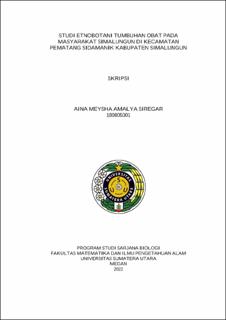Studi Etnobotani Tumbuhan Obat pada Masyarakat Simalungun di Kecamatan Pematang Sidamanik Kabupaten Simalungun
Ethnobotany Study of Medicine Plants in The Simalungun Community in Pematang Sidamanik District Simalungun Regency

Date
2022Author
Siregar, Aina Meysha Amalya
Advisor(s)
Aththorick, T Alief
Metadata
Show full item recordAbstract
The study of the ethnobotany of the medicinal plants at the Simalungun Community, Pematang Sidamanik District, Simalungun Regency, North Sumatra was aim to determine the utilization, the perception, the types of medicinal plants and t knowledge degradation of the medicinal plants in the place. The research was conducted from February to April 2022. The research location covered three villages which are Sarimattin, Saitbuttu Saribu, and Pematang Sidamanik. The method used was an open-ended interview through questionnaires. The open-ended interviews were conducted openly and in depth to the key informants, such as the traditional physicians, about the types of medicinal plants, the plant parts used, the processing, and how to use them. Questionnaires were also conducted to the public to determine the social, the economic impacts and the knowledge of the medicinal plants. There were 85.71% of the people at the villages at the Pematang Sidamanik belief in the traditional medicine. The most common diseases suffered by the people were fever, colds, convulsions, cough, dysentery, ulcers, stomach acid, hypertension, heartburn, and sprains. Base on the plant identification, there were 77 species of the medicinal plants obtained, which are consist of 34 families. The results of the ICS (Index Of Cultural Significance) calculation showed that Curcuma longa had the highest ICS value, which was 220. The knowledge degradation on the A to C age group was 53.44%. Parts of plants often used as medicine were the leaves, the bark, the fruit, and the seeds. The method of processing plants into ingredients was by boiling, chewing, spraying, grinding, and consuming directly. The way to use the medicinal plants was mostly by drinking and applying it to the body.
Collections
- Undergraduate Theses [930]
